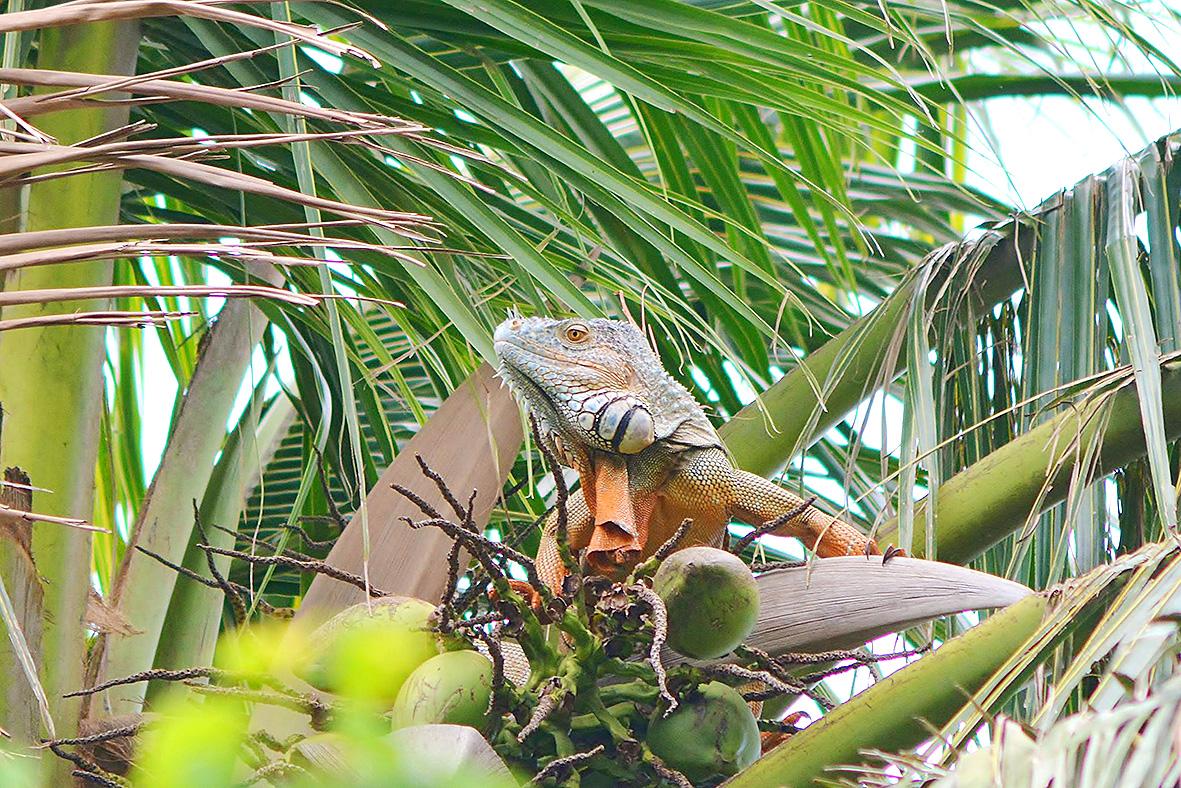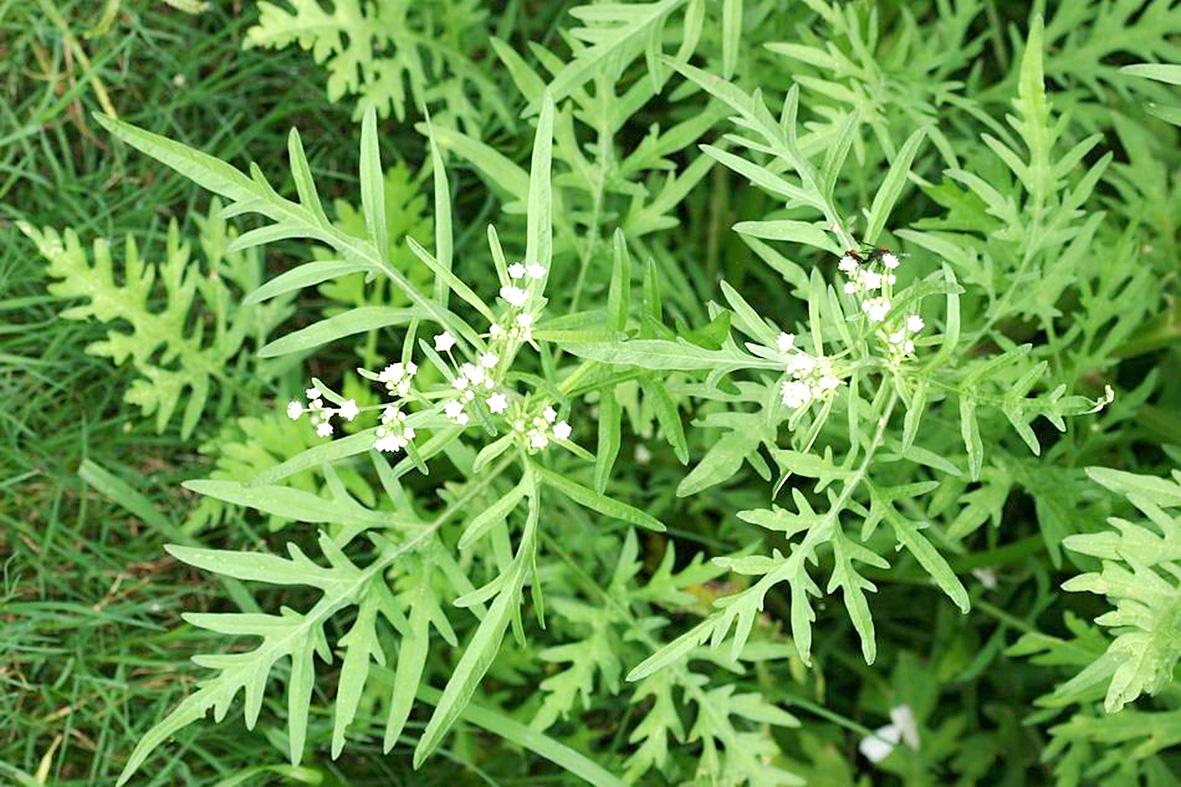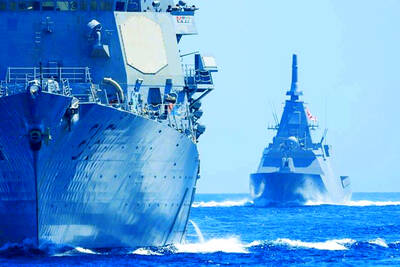When I visited John Lamorie’s eco-farm in Pingtung a few weeks ago, the first thing I saw when I stepped out of his car was an iguana running along the ditch that borders his property. “It’s been hanging around there for weeks,” he said. “Can’t get rid of him.”
An invasive species from an exotic land that looks like a monster (the 1998 Godzilla film hints that Godzilla is a mutated iguana), iguanas have been in the spotlight for a year now, with a spate of articles highlighting their growing presence in southern Taiwan. The government banned their import in 2015, and 15,000 were killed in Taiwan last year, over 8,000 in Pingtung alone.
Like most invasive species in sensitive island environments, they are extremely destructive. They burrow, damaging irrigation infrastructure, and they compete with local species for resources. They were first reported on Taiwan island in 2004, likely as the result of an intentional release. Several local governments now offer bounties for them.

Photo: CNA
‘INTERESTING CASES OF SPECIATION’
Taiwan is a special place. Because it sits on the boundary between two major zoogeographical zones, the Indomalaya and the Palearctic, it hosts lineages from both areas. There are over 100 amphibians and lizards native to Taiwan, with roots in both regions.
Since Taiwan is cut up into numerous tiny regions by high mountains and fast-moving rivers, the island presents interesting cases of speciation. For example, lizards of the genus Takydromus are distributed widely in the Palaearctic regions, and reach their greatest diversity in Taiwan. A 2015 paper found that speciation occurred between T. viridipunctatus and T. luyeanus, two species separated by a narrow stream only 15 meters wide, “one of the narrowest contact zones ever documented in terrestrial vertebrates”, the authors observed.

Photo courtesy of Hualien County Government
Invasive species threaten these unique and precious creatures. The many-lined sun skink, which was first found in southern Taiwan in 1992, likely introduced as a result of timber imports, has reduced populations of native skinks in the south. Similarly, the tree frog Polypedates megacephalus, first noted in 2006, has pushed out a local cousin whose niche it also competes in wherever it appears in Taiwan.
Smaller introduced pests, such as the white spotted longhorn beetle, rice water weevil, the pine wood nematode, and the apple snail, do great and costly harm to the ecosystem and the economy. The pine wood nematode causes pine wilt, which kills pine trees. It can fell a healthy tree in less than two weeks. Outbreaks in Taiwan in the 1990s caused great damage to Taiwan’s native pines, including the hardy Taiwan red pine.
The story of the pine wood nematode is intertwined with the story of other introduced species. On the plains, most pines are introduced. For example, the Japanese black pine was planted by settlers after they cleared the native coastal forests, because it is wind and salt resistant.

Photo: CNA
In 1960s Luchu pines were planted in northern Taiwan to provide fodder for pulpwood mills. They became so common that then-Taipei County chose the plant as its county tree. Unfortunately, it proved unsuccessful as a source of pulp. The trees were left to run wild by plantation owners, and they later became excellent hosts for the pine wood nematode.
The white spotted longhorn beetle, a familiar sight with its long black body, long antennae, and white spots, is an import from elsewhere in Asia. Its larvae cause millions in fruit losses each year. To avoid drenching their orchards with pesticides, farmers in Taiwan now kill them by the tedious process of injecting compressed air into the trunks of their fruit trees.
GREEN DAMAGE
The public discussion focuses on exotic animals, insects, and fish (snakeheads in Sun Moon Lake were again in the news this week). Plants seldom get much attention. Yet the damage they do is immense.
Consider American rope aka climbing hemp (Mikanthia micrantha), a climbing plant now found in the mountains of Hualien, Taitung, Changhua, and Nantou. Its seeds are miniscule (a thousand can weigh less than a gram), easily spread by wind, insects, animals, and humans. Plants and trees covered by American rope obtain less sunlight, and may die.
The Japanese introduced the water hyacinth as an ornamental. Long out of control, it now blocks waterways of every type and clogs reservoirs and power plants. It sucks the oxygen out of the water and drives a threefold increase in evaporation. It is deadly to local life forms, while creating habitats for harmful bugs and destroys aquaculture. At some local reservoirs grass carp, which eats hyacinth, is used for pest control.
Another water plant, Saltmarsh cord grass, often planted in intertidal areas because it captures sediment and engineers shorelines, is a pest in Taiwan. It can block water infrastructure and create conditions that extinguish local lifeforms.
Taiwan now hosts the extremely destructive Parthenium hysterophorus, a plant so toxic to other plants it is colloquially known as “famine weed” because of the way it suppresses crop yields with nasty chemicals. It also causes dermatitis in both humans and domestic animals, and respiratory malfunction and allergies in humans. Having spread to over 30 countries, the European Union has banned its sale and importation. It colonizes disturbed land, of which there is plenty in Taiwan with our constant construction churn, and spreads through contaminated feed and even plant bouquets.
Invasive species also carry diseases. Some species of invasive slugs and snails in Taiwan carry a worm that causes a form of meningitis in humans, including the ubiquitous giant African snails.
Mirroring their behind-the-scenes existence, Taiwan also has programs seldom observed by the public to control and eventually eradicate imported pests. The Polynesian Rat likely traveled to Taiwan by ship. It was first spotted in Taiwan in the late 1990s, in Hualien. The Bureau of Animal and Plant Health Inspection and Quarantine (BAPHIQ) of the Council of Agriculture (COA) immediately initiated a program to use poisoned baits to reduce its population and prevent its spread.
With the red fire ant, one of the most obnoxious of invasive species, local governments have established offices specifically to attack the pest. For example, New Taipei City has an agency, the Red Imported Fire Ant Center, devoted to suppressing the ant. The center said in a recent article that it had reduced the areas infested by the creatures from 7,000 hectares to 4,000.
Still, madly, we continue to permit exotic creatures to be imported. Exotic pets sold in Taiwan include monitor lizards, snapping turtles, and pythons, all of which could find a congenial home on the island. Even if such trade were forbidden, Taiwan’s dependence on imports means that invasive species will arrive riding on otherwise innocuous goods.
The government does what it can to limit the entrance and spread of invasive species, but what is really needed is better public education in the dangers of keeping exotic pets and intentionally releasing unwanted animals into the wild. Long-term cultural change, something the Taiwanese have repeatedly shown they are capable of, would really help Taiwan in this case.
Notes from Central Taiwan is a column written by long-term resident Michael Turton, who provides incisive commentary informed by three decades of living in and writing about his adoptive country. The views expressed here are his own.

The Nuremberg trials have inspired filmmakers before, from Stanley Kramer’s 1961 drama to the 2000 television miniseries with Alec Baldwin and Brian Cox. But for the latest take, Nuremberg, writer-director James Vanderbilt focuses on a lesser-known figure: The US Army psychiatrist Douglas Kelley, who after the war was assigned to supervise and evaluate captured Nazi leaders to ensure they were fit for trial (and also keep them alive). But his is a name that had been largely forgotten: He wasn’t even a character in the miniseries. Kelley, portrayed in the film by Rami Malek, was an ambitious sort who saw in

It’s always a pleasure to see something one has long advocated slowly become reality. The late August visit of a delegation to the Philippines led by Deputy Minister of Agriculture Huang Chao-ching (黃昭欽), Chair of Chinese International Economic Cooperation Association Joseph Lyu (呂桔誠) and US-Taiwan Business Council vice president, Lotta Danielsson, was yet another example of how the two nations are drawing closer together. The security threat from the People’s Republic of China (PRC), along with their complementary economies, is finally fostering growth in ties. Interestingly, officials from both sides often refer to a shared Austronesian heritage when arguing for

Among the Nazis who were prosecuted during the Nuremberg trials in 1945 and 1946 was Hitler’s second-in-command, Hermann Goring. Less widely known, though, is the involvement of the US psychiatrist Douglas Kelley, who spent more than 80 hours interviewing and assessing Goring and 21 other Nazi officials prior to the trials. As described in Jack El-Hai’s 2013 book The Nazi and the Psychiatrist, Kelley was charmed by Goring but also haunted by his own conclusion that the Nazis’ atrocities were not specific to that time and place or to those people: they could in fact happen anywhere. He was ultimately

Last week gave us the droll little comedy of People’s Republic of China’s (PRC) consul general in Osaka posting a threat on X in response to Japanese Prime Minister Sanae Takaichi saying to the Diet that a Chinese attack on Taiwan may be an “existential threat” to Japan. That would allow Japanese Self Defence Forces to respond militarily. The PRC representative then said that if a “filthy neck sticks itself in uninvited, we will cut it off without a moment’s hesitation. Are you prepared for that?” This was widely, and probably deliberately, construed as a threat to behead Takaichi, though it